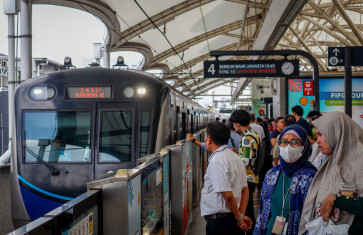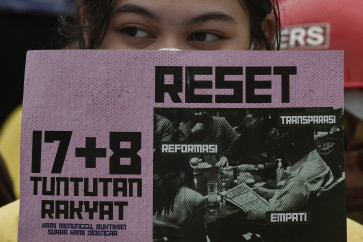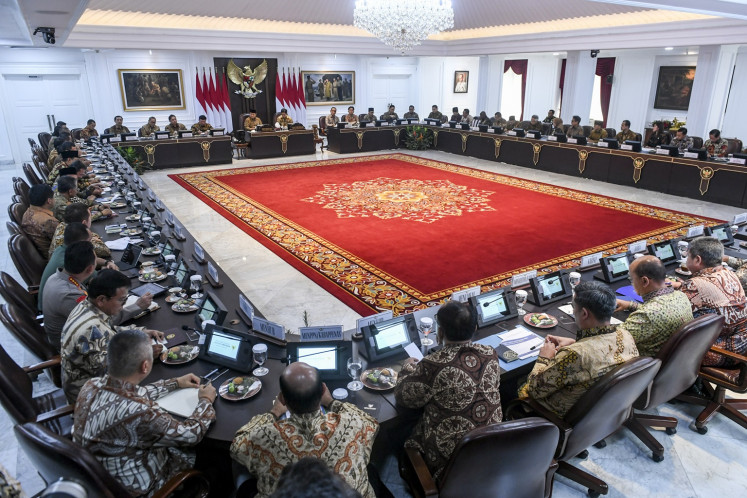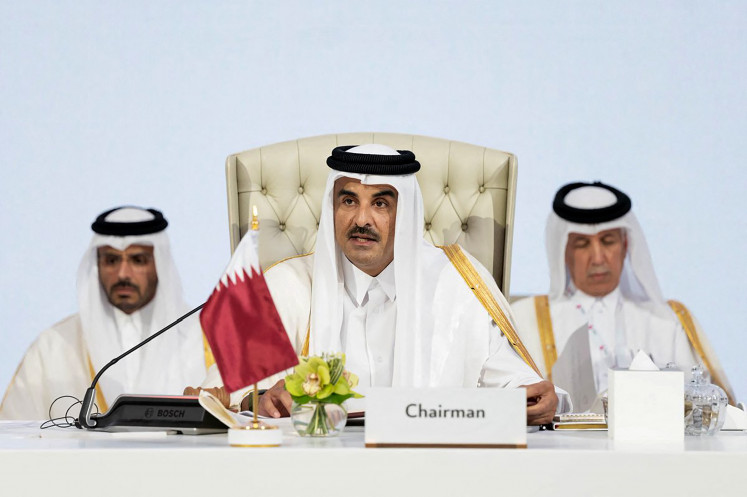Popular Reads
Top Results
Can't find what you're looking for?
View all search resultsPopular Reads
Top Results
Can't find what you're looking for?
View all search resultsGamelan, Debussy reunited at Impressions Universelles
Reenacment: The melody of the historic Sari Oneng gamelan set accompanies a dance performance at Impressions Universelles concert in Jakarta
Change text size
Gift Premium Articles
to Anyone
R
eenacment: The melody of the historic Sari Oneng gamelan set accompanies a dance performance at Impressions Universelles concert in Jakarta.
More than 100 years ago, the tunes of the Sari Oneng gamelan set enchanted French composer Claude Debussy at the World Fair in Paris. The historic gamelan set once again showcased its charming sounds at a recent concert in Jakarta.
Long before Indonesia gained its independence, the Sari Oneng Parakansalak gamelan set from Sumedang, West Java, had traveled the world.
Put together in 1825 in Sumedang, the gamelan set’s Europe journey started in Amsterdam in 1883. It also appeared at the World Fair (Exposition Universelle) in Paris in 1889, as part of the Le Kampong Javanais (Javanese Village) pavilion where 65 Indonesians lived in a recreated village showcasing Indonesian culture.
It was at the pavilion that then 27-year-old Claude Debussy and 14-year-old Maurice Ravel discovered the sounds of gamelan, and later incorporated its unique melody into their works.
“And if one listens to it without being prejudiced by one’s European ears, one will find a percussive charm that forces one to admit that our own music is not much more than a barbarous kind of noise more fit for a traveling circus,” Debussy claimed in one of his writings compiled in the Debussy on Music book.
Debussy and Ravel grew to become prominent composers of the 20th century. The Sari Oneng gamelan set, meanwhile, returned home and became a permanent fixture of the Prabu Geusan Ulun Museum in Sumedang.
On May 11, the iconic gamelan set relived its glory in the Impressions Universelles classical music concert at Aula Simfonia, North Jakarta. The concert celebrated the 130 years of the Eiffel Tower and the 1889 World Fair.
Spirited: Conductor Gabriel Laufer says the 1889 World Fair played an important role in paving the way for modern music.The gamelan was brought in alongside the performers from the Prabu Geusan Ulun’s Dangiang Kutamaya dance studio.
Four Javanese dancers aged 12 to 16 from the Darma Giri Budaya dance studio in Wonogiri, Central Java also participated in the concert, reenacting the exact dance that four young dancers from the Surakarta Palace performed 130 years ago at the Paris’ world fair.
Conductor Gabriel Laufer told The Jakarta Post that the concert tried to reproduce the original setup of the fair’s exhibition, basing it on historical documents and pictures.
“I think it’s an important anniversary [...] because this event is a major turn in music history.”
“It is probably one of the most striking moments because it opened the way to the 20th century and to what we call modern music. It is the classical music of the modern era,” Laufer said, noting that Debussy was widely agreed to be the progenitor of modern music.
The Belgian-French Laufer himself also had some prior experience with the gamelan, having played it since 1996 at the Indonesian Embassy in Brussels.
“As a percussionist, I was of course in heaven playing all these percussive instruments. For me, it was also a big shock [coming across] a new perspective of music. I probably felt a similar feeling like Debussy had, because I was finishing my studies and then I discovered that there’s a whole new world within the music; it is percussion, but it is a completely different language.”
So great was the gamelan’s influence on Debussy that the majority of the concert’s first half was dedicated to Debussy compositions, performed alternatingly with traditional Indonesian music.
Standing ovation: The Impressions Universelles concert marked 130 years of the Eiffel Tower and the 1889 World Fair in Paris.The first performance of the night was the traditional Sundanese song “Kentar Cisaat”, performed with the suling (bamboo flute). The piece was juxtaposed with the flute performance of Debussy’s “Syrinx, L. 129.”
Two sinden (singers) sang West Javanese tembang poems such as “Jemplang Cidadap-Muara Beres-Kaleran” and “Bolebat” accompanied with the melodies of suling, rebab (a two-string bowed instrument), and kecapi (zither). The sinden performance was contrasted with Debussy’s more intricate compositions, such as the piano-focused “Pagodes” and the soprano-harp combination in “Beau soir”.
A gamelan orchestra came and played the Sari Oneng gamelan around halfway into the concert, first performing “Wani Wani” solo before providing the music for Damarwulan, a dance-theater performance centered on a legendary Javanese heroic figure.
The dancers’ performance drew a standing ovation from the full-house crowd.
A 30-minute break was followed by the performance of the Jakarta Simfonia Orchestra as conducted by Laufer. Debussy’s works were still prominently featured, particularly in the three-movement “Nocturnes” as accompanied by the Jakarta Oratorio Society female chorus in the third movement “Sirènes”.
The concert was concluded with Ravel’s “Ma mère l’Oye” suite, where the audience can clearly notice the composer’s tribute to the gamelan in the middle section. The four dancers returned to the stage nearing the finale, striking a pose at the end and receiving another round of standing ovation.
Laufer noted that the concert and the celebration were important to him, as it signified the realization that “Indonesian heritage was feeding the Western heritage”.
“This is not a parody, this is not just ‘a la Indonesia’ if you want; the way gamelan is played, the way the concept of traditional music exists here in Java is a consistent inspiration for Debussy.”
In sync: The concert highlighted the works of French composers Claude Debussy and Maurice Ravel, who were inspired by the gamelan after a chance encounter at the fair.— Photos courtesy of STEMI Photography/Aula Simfonia Jakarta













